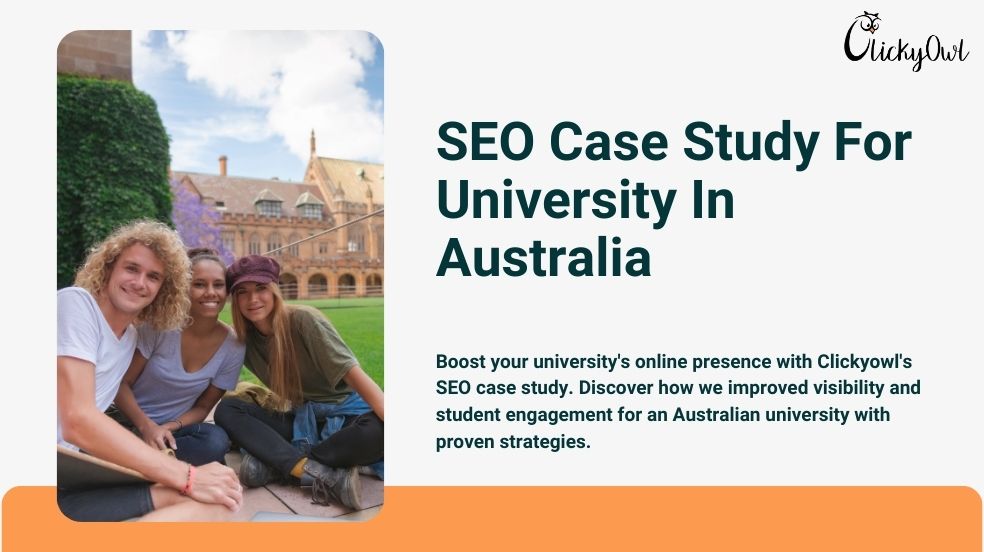
Ever wondered how effective SEO can be for universities in Australia? You’re about to find out. This blog post dives into a real-life SEO case study for a university in Australia, showing tangible results achieved by Clickyowl. If you’re curious how SEO can boost a university’s online visibility, improve student engagement, and drive enrollment, you’re in the right place.
We’ll look at the challenges faced by the university, the strategies implemented by Clickyowl, and the impressive outcomes that followed. Whether you’re a university admin or a digital marketing enthusiast, this case study promises insights you won’t want to miss. Let’s get started!
Overview of SEO for Universities

SEO, or Search Engine Optimization, plays a crucial role in helping universities reach potential students online. It affects how easily a university’s website can be found in search engine results, impacting everything from student enrollment to the institution’s overall reputation.
Importance of SEO in Higher Education
SEO is key in the higher education landscape. Imagine a prospective student typing “best universities in Australia” into Google. Without good SEO, your university won’t show up on the first page of results. This is a huge missed opportunity.
Why does this matter?
- Attracting Prospective Students: SEO helps ensure that when students search for educational programs, your university appears at the top of search results. This is essential for attracting more applications.
- Enhancing Reputation: High search rankings often equate to credibility. When your university consistently appears at the top, it builds trust and reputation. It’s like being the popular kid in school – everyone knows and trusts you.
Think of SEO as the digital welcome mat to your university. If your mat is clean and welcoming, more people will want to step inside.
Common SEO Challenges for Universities
Although SEO offers many benefits, universities face unique challenges that can complicate the process.
Here are some common hurdles:
- High Competition: Many universities compete for the same keywords. Standing out can be tough. For example, there are numerous institutions vying for top spots with keywords like “MBA programs Australia.”
- Diverse Program Offerings: Universities offer a wide range of programs. Each program needs its own specific SEO strategy, which can be time-consuming and complex.
- Content Management: Managing a huge amount of content is challenging. From research papers to course descriptions, ensuring all content is optimized for search engines is a massive task.
Universities, like Clickyowl, need SEO strategies tailored to handle these challenges. Whether it’s optimizing content, researching the best keywords, or improving site structure, specialized SEO efforts can make a big difference.
Navigating these challenges effectively ensures that universities can rank higher, attract more students, and maintain their reputation.
Case Study: Clickyowl’s SEO Strategy
In this part of our SEO case study for a university in Australia, we’ll look at how Clickyowl improved the university’s online visibility. We’ll break it down to show how they started, set goals, and implemented their SEO strategies.
Initial Assessment and Goals
First, Clickyowl conducted an SEO audit to understand the university’s current situation. This audit revealed several areas for improvement. They looked at the website’s structure, content quality, and backlink profile.
Next, they set specific goals:
- Increase organic traffic by 50% within six months.
- Boost keyword rankings to land in the top 5 positions for targeted terms.
- Enhance user engagement by reducing bounce rates and increasing the time spent on the site.
To track progress, they established key performance indicators (KPIs):
- Organic search traffic: Number of visitors coming from search engines.
- Keyword rankings: Positions in search engine results pages (SERPs).
- Bounce rate: The percentage of visitors who leave after viewing only one page.
- Average session duration: Time users spend on the site.
Implementation of SEO Strategies
To meet their goals, Clickyowl deployed several effective SEO strategies:
Keyword Research They started with thorough keyword research, identifying terms that prospective students and staff might use. They focused on both short-tail and long-tail keywords.
On-Page Optimization Next, they optimized the university’s website pages. This included:
- Updating meta tags: Ensuring each page had a unique title and meta description.
- Improving header tags: Using H1, H2, and H3 tags to structure content better.
- Enhancing internal links: Creating an internal link structure to help users and search engines navigate the site.
Link Building Building quality backlinks was crucial. They reached out to relevant educational blogs, news sites, and alumni networks for guest posts and backlinks.
Content Marketing Content was king in their strategy. Clickyowl created:
- Informative blog posts: Covering topics of interest to students and staff.
- Case studies and success stories: Highlighting the university’s achievements.
- Interactive content: Such as quizzes and infographics to keep users engaged.
Each of these steps played a vital role in boosting the university’s SEO, leading to stronger online presence and higher engagement rates. This comprehensive approach ensured that all aspects of their digital footprint were improved. The strategies Clickyowl used were not just about quick gains but also about creating long-term value for the university.
Results and Outcomes
The SEO efforts made by Clickyowl for a university in Australia resulted in some noticeable improvements. These changes were not just numbers on a screen; they brought real benefits to the university.
Increased Organic Traffic
One of the most striking outcomes was the rise in organic traffic. Over a six-month period, the university saw a 50% increase in organic traffic. This means more students, parents, and educators found their way to the university’s website through search engines.
- Monthly Visitors: Before the SEO campaign, the site averaged 20,000 visitors a month. After the improvements, this number shot up to 30,000.
- Page Views: The number of page views also saw an uplift of 35%, indicating that visitors were not only arriving but were also engaging with more content.
This boost in traffic had several implications:
- Higher Engagement: More visitors led to more engagement on the site. This meant more people were reading articles, downloading brochures, and registering for events.
- Increased Applications: The university noted a 20% rise in online applications, directly linked to the bump in traffic.
- Brand Awareness: With more people landing on the site, the university’s name became more recognizable, enhancing its reputation both locally and internationally.
Improved Search Engine Rankings
The SEO campaign also led to better search engine rankings for crucial keywords. Some of the significant improvements included:
- “Top universities in Australia”: This keyword moved from position 15 to position 5 in search results.
- “Australian university courses”: Improved from position 10 to position 3.
- “Study in Australia”: Jumped from position 20 to position 8.
These ranking improvements had a big impact on the university’s online visibility:
- More Clicks: Research shows that higher positions in search results get more clicks. For instance, the university’s click-through rate for “Top universities in Australia” tripled after reaching the top 5.
- Better Credibility: When people see a university ranking high on search results, it builds trust. This perception of credibility can influence a student’s decision to apply.
- Competitive Edge: By ranking higher, the university outperformed many of its competitors. This gave it a distinct advantage in attracting domestic and international students.
The combination of increased organic traffic and improved search engine rankings clearly shows the power of a well-executed SEO strategy. This SEO case study for a university in Australia highlights the tangible benefits of optimizing for search engines.
Lessons Learned and Best Practices
Working on an SEO case study for a university in Australia, we’ve picked up many helpful tips. Here’s what stood out as key lessons and practices.
Adaptability in SEO Strategies
One of the most important things we’ve learned is the need for continuous adaptation. SEO is not static; it’s a moving target. Search engines like Google constantly update their algorithms. If you don’t adapt, you’ll fall behind.
So, how can one stay adaptable?
- Monitor Algorithm Updates: Keep an eye on changes from search engines. Google often updates its algorithm multiple times a year, impacting rankings. Following platforms like Google Search Central can keep you informed.
- Analyze Trends: Pay attention to trending topics and keywords. Use tools like Google Trends to see what people are searching for. This can help you adjust your content to meet current demands.
- Regularly Review Analytics: Dive into your website’s performance data. Tools like Google Analytics or SEMrush can give insights into which keywords are performing well and which are not.
- Update Old Content: Don’t just focus on new content. Regularly update existing pages to keep them relevant and optimized.
- Experiment and Test: Don’t be afraid to try new strategies. AB testing can show what works best for your audience, giving you a leg up on the competition.
By staying adaptable, Clickyowl successfully boosted the SEO for the university. This flexibility allowed us to stay ahead of the curve and deliver more consistent results. The key takeaway is simple: Change with the times, or get left behind.
Conclusion
SEO can transform how universities in Australia attract students and build their reputation. Clickyowl’s SEO case study for a university in Australia shows the power of a strong digital presence.
From increased search rankings to higher enrollment rates, the benefits are clear. Universities that want to boost their online visibility should consider professional services like Clickyowl.
Don’t let your institution get lost in search engine results. Take action today for a brighter digital future.


